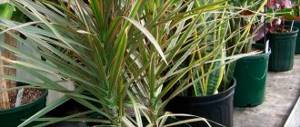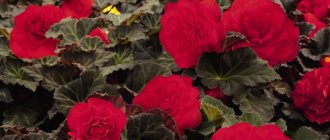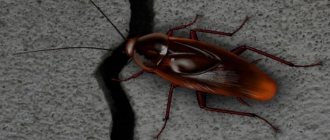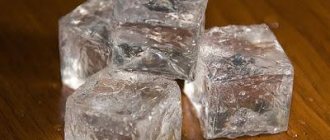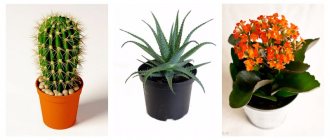Photo of Kalanchoe plant (Kalanchoe) is a perennial plant of succulent type, belonging to the Tolstyankov family. Most species are native to South Africa, Madagascar and the Mediterranean islands, as well as Southeast Asia.
The size of the plant varies and largely depends on the species: it can reach a height of 6 cm to 2 meters.
Kalanchoe is a perennial plant, but after 5-6 years it begins to lose its decorative appearance: it begins to stretch in height, its stems become bare. In this regard, the bushes need to be periodically rejuvenated.
Look also at the beautiful zephyranthes plant.
| The growth rate is high; cuttings produce a full-fledged flowering plant in one season. |
| Flowering occurs only once a year; for most species it occurs at the end of winter - beginning of spring. |
| The plant is easy to grow. |
| It is a perennial plant. |
Beneficial features
Photo of Kalanchoe in a pot
The plant is most often used in traditional medicine recipes due to its anti-inflammatory effect, and is used as a local remedy (rinses, lotions for diseases of the teeth, eyes, nasopharynx, burns and bedsores). Kalanchoe juice has a beneficial effect on vascular tone, helps in the fight against pain and bleeding.
Beneficial properties of Kalanchoe and use in folk medicine
Kalanchoe has many beneficial properties. In particular, the plant has the following medicinal effects:
- wound healing;
- anti-inflammatory;
- hemostatic;
- antiseptic;
- tonic;
- regenerative;
- cleansing;
- immunostimulating.
Beneficial properties
Traditional medicine uses indoor flowers to treat the following diseases:
- Bedsores, ulcers, difficult-to-heal wounds.
- Ulcers, boils.
- Skin rash.
- Burns.
- Eczema.
- Consequences of insect bites.
- Chronic fatigue.
- Gastrointestinal diseases, including ulcers.
- Impaired kidney function.
- Cervical erosion.
The plant is especially popular among people with colds and runny nose. Previously, the popular medicine for the common cold was the drug Naphthyzin, which was contraindicated for small children. Mothers made do with Kalanchoe juice, so now many people associate this flower with sneezing and childhood.
Traditional medicine also recognizes the medicinal properties of this plant, but, unlike traditional medicine, it uses plant components only for external use.
Features of growing at home. Briefly
| Temperature | In summer up to 27 °C (room temperature), and in winter no more than 15 °C. |
| Air humidity | Low. |
| Lighting | Needs sunlight. |
| Watering | Does not tolerate excess moisture; water once every 5-10 days. |
| Priming | The best option is soil for succulent plants with added sand. |
| Feeding and fertilizer | During active growth, once every few weeks you can feed the plant with special compounds for succulents. |
| Transfer | Kalanchoe transplantation at home is carried out in the spring immediately after flowering. |
| Reproduction | Reproduction occurs by seeds and apical shoots. Viviparous species can reproduce by daughter plants. |
| Features of cultivation | The plant grows easily. It is undesirable for water to get into the center of the bush when watering; the leaves of the flower are fragile and can be easily damaged. |
Description of Kalanchoe species
Kalanchoe Blossfeld is a small compact plant with low straight stems covered with elongated, fleshy, succulent leaves.
Dense clusters of inflorescences, consisting of a large number of small double and semi-double flowers, are distinguished by various shades of red, yellow, orange, pink, purple and white. The bright color scheme contrasts effectively with the dark green foliage.
Flowering begins in winter or early spring, and lasts for several months. On sale you can often find a magnificent hybrid of this species - Calandiva.
Kalanchoe blossfeldiana
Kalanchoe pinnata is grown primarily as a valuable medicinal plant. In nature, its height can reach more than 150 meters.
In home conditions with limited space, the bush usually grows up to 50 cm. The leaves are quite peculiar, large, odd-pinnate, corrugated with teeth along the edge of the leaf plate.
Caring for Kalanchoe at home. Details
Bloom
Kalanchoe blooms at home once a year, and the period and duration of this process depends on the species.
In order for flowers to bloom faster at home, the plant needs to reduce the duration of exposure to light to 10-12 hours a day. The remaining hours of lighting should be bright - this allows large and colorful flowers to bloom in the future.
Temperature
Feels comfortable over a wide range of temperatures. In summer it can reach 28 °C, and in winter up to 10 °C, with the optimal temperature being between these values.
In a hot room, the plant may develop diseases and the formation of flower buds may be disrupted.
Spraying
The plant does not need to spray the leaves, since a low level of humidity is required for its comfortable existence. Types of Kalanchoe with velvety leaves quickly rot from spraying, since drops of water are trapped between the thin hairs covering the plant.
Lighting
Homemade Kalanchoe loves light, but in the summer it must be protected from direct sunlight: this can damage the fragile and sensitive leaves of the plant. From hot rays, the leaves begin to turn red with the appearance of burns.
Therefore, in summer the plant should be kept on the east or southeast side to prevent damage. In winter, this rule is not particularly important, since the sun's rays are not so intense.
Watering
The amount of water and frequency of watering depends on the time of year and the conditions of the plant.
In late spring and summer, the plant is watered abundantly if the flower spends a lot of time in the sun. In winter, watering is carried out less frequently, but does not stop altogether: with a lack of moisture, the leaves begin to dry out. Water is poured onto the plant not from above (this can lead to rot), but into the pot tray.
Pot
Clay pots are the most preferable for growing indoor Kalanchoe. This material is very porous, which promotes good breathing of the plant's root system and has a beneficial effect on good growth and flowering in the future.
The size of the pot is selected based on the size of the flower.
The pan should be large so that excess liquid flows out of it, and it will be more convenient to water.
Priming
Kalanchoe mix.
Photo It is better to take soil for replanting with a neutral or slightly acidic environment. The optimal soil composition is leaf and turf soil, and the latter should be twice as much. A little sand and humus is added to them.
There needs to be well-functioning drainage at the bottom of the pot. Grows well using the hydroponic growing method.
Feeding and fertilizer
To grow Kalanchoe at home, you can buy special fertilizers for succulents. The plant should be fertilized once a month in spring and summer, and as winter approaches, reduce this amount. In winter it does not need feeding at all.
Replanting Kalanchoe
Carried out as needed. Typically, young plants need to be replanted once a year, and older plants less often - once every two to three years. It is advisable to replant in the spring after flowering.
How to trim
After Kalanchoe stops blooming, the plant's stems need to be pruned to maintain a beautiful appearance. Otherwise, as they grow, they begin to bend, their nutrition is disrupted and the stems gradually dry out. Long shoots can be used as cuttings for further propagation.
Rest period
It is weakly expressed and occurs at the end of winter after flowering. The plant must be placed in a place where it does not receive direct sunlight.
This period lasts about 1-1.5 months.
How to make Kalanchoe bloom
After flowering has ended, the plant needs to be prepared for the next one. To do this, it is necessary to cut off all excess and old shoots, and on young ones, pinch the leaves on top. This manipulation should be repeated after the third pair of leaves has appeared on the shoot. Just before the beginning of the flowering period, the last pinching is carried out.
In order to make Kalanchoe bloom, you can perform “shock therapy”. Flowering is necessary for reproduction, and it occurs when conditions are unsuitable for the plant (as a need to survive). The plant is placed in a cool and dark place for three weeks without watering it. Then it is placed in its original place, gradually introducing watering and fertilizers back. Within a short time you can see the plant blooming.
Kalanchoe. Care and cultivation. Kinds. Beneficial features.
Kalanchoe is a representative of the Crassulaceae family. This genus includes more than 200 different species, and it is represented by subshrubs, succulents and herbaceous perennial plants. In nature, this plant can be found in the tropical regions of Asia, Australia and America. Foliage may differ between species. As a rule, the leaves are thick, they are sessile or have petioles, and they can also be slightly or strongly dissected. During flowering, an umbrella is formed, which includes flowers of white, purple, red or yellow color. Almost all types of this plant grow well at home, unless, of course, the grower adheres to the rules of caring for the crop.
Caring for Kalanchoe at home
The plant is also known under the names Home Doctor, Home Ginseng and Tree of Life, and is very often found in our homes. All popular names of Kalanchoe are more than justified and accurate: the juice of the plant has healing properties and is widely used in medicine.
This wonderful plant is so not picky and hardy that it can adapt to almost all growing conditions and forgive its owner many mistakes in care, even its absence. Any novice gardener, as well as all those who are not disciplined in caring for plants, can grow Kalanchoe. However, this does not mean that the plant will not require attention at all. Care is needed, and if you have it, Kalanchoe will delight you not only with its benefits, but will also decorate your home.
Lighting
Kalanchoe is not demanding of light. In summer, the flower will be comfortable on western and eastern windows. In winter, southern ones are preferable. If the plant is exposed to bright sunlight, it may get burned. Therefore, in summer it needs to be shaded. With a lack of light, the House Doctor stretches out, its flowers become small and inconspicuous.
A prerequisite for Kalanchoe flowering is a 12-hour daylight period. If you are interested in regular and abundant flowering of the plant, then take care to comply with this condition by shading the plant in the summer and increasing, with the help of artificial lighting, the length of the light in the fall and winter.
Temperature
Kalanchoe can grow well in almost any air temperature. But you shouldn’t go to extremes! In summer, temperatures can vary from 18 to 28 degrees, and in winter - from 14 to 18 degrees. If the temperature in the room drops to 10 degrees (or lower), then the plant may get sick and die. During cold wintering (14–18 degrees), flower buds are formed.
Humidity
Kalanchoe is “indifferent” to air humidity. He feels great in a warm room with dry air. Easily tolerates high humidity at low temperatures. However, a light spray will not harm it. It is used for hygienic purposes. After spraying, wipe the Kalanchoe leaves with a soft cloth or sponge.
Watering
The Tree of Life, despite being a succulent, needs to be watered regularly. The watering schedule for a plant is determined by the air temperature, size and condition of the plant. In summer, in dry and hot weather, not only regular, but also abundant watering is required.
In a shaded room, Kalanchoe is watered moderately, once every 2-3 days, focusing on the condition of the soil. In winter, watering is reduced to a minimum.
Kalanchoe tolerates lack of moisture quite easily, but is very sensitive to waterlogging.
The soil
Any soil is suitable for growing Kalanchoe, for example for succulents, which can be purchased at any flower shops. If desired, you can make the soil mixture yourself by taking equal parts of leaf and turf soil, peat and sand. It is advisable to add charcoal or perlite to the mixture. There should be drainage at the bottom of the pot.
Feeding
“Homemade ginseng” responds gratefully to fertilizing, which is carried out with any fertilizer for cacti. An optimal feeding scheme has also been developed experimentally: once every 2 weeks, starting from the second half of May until mid-July. Feeding is resumed in late autumn, timed to coincide with the period of formation of flower buds.
Trimming
Since most Kalanchoe species shed old leaf blades, such shoots can, if desired, be cut off and planted in the same or in an individual container. And in other species, the stems may fall over the edge of the planting container, in which case you can also cut them and plant them nearby, but you don’t have to touch them.
Bloom
In order for Kalanchoe to delight you with lush flowering, the duration of daylight in spring and summer should be no more than 10–12 hours. However, the lighting must be very bright. In some species, flowers can be cut and placed in a vase with water, where they can stand for a relatively long time. After flowering is over, some of the shoots can be cut off, which will allow you to form a neat bush. If necessary, the cut stems can be rooted.
Transfer
Kalanchoe is replanted only when it grows strongly and becomes cramped in the pot. At the bottom of the planting container you need to make a good drainage layer from small pieces of brick or expanded clay. This will avoid stagnation of water in the substrate. For replanting young bushes, a soil mixture containing peat, sand, deciduous and turf soil in a ratio of 1:1:2:4 is suitable. If you wish, you can buy ready-made substrate for succulents in the store. When transplanting epiphytic Kalanchoe into the soil mixture, it is recommended to add a small amount of humus.
Reproduction methods
Kalanchoe reproduces very easily, sometimes with minimal human intervention. It is enough for a baby or a leaf to break away from the plant and fall on the soil, it has every chance to grow on its own.
Reproduction by children
Answering the question of how Kalanchoe reproduces by brood leaf buds (babies), it should be noted that not all types of this succulent have them. Small daughter plants are formed on the leaves of the “viviparous” Kalanchoe. Other varieties of this flower do not form them. Kalanchoe babies have several leaves and roots. Adult succulents often independently shed brood buds, which take root at the foot of the mother plant. They can be planted in separate pots with fertile substrate. Fully formed shoots are carefully broken off from the adult leaf and buried slightly into the prepared substrate.
Propagation by leaf blades
Kalanchoe can be propagated by leaves at any time of the year. To do this, cut off an adult leaf and plant it in a pot with a well-moistened fertile substrate. The leaf is covered with a glass or jar. After a few days, the leaf takes root and a full-fledged plant soon forms from it. For propagation, parts of the leaf blade buried in the soil are often used. Young plants also develop quickly from them.
Propagation by cuttings
Kalanchoe, which can be propagated by cuttings during the formation of a bush or transplanting a plant, takes root in moist soil in just 2 weeks. Strong shoots are chosen for cuttings. They can be of any length, but it is best to shorten them to 6-8 cm. Most often, the tops of the shoot are used for this, which are distinguished by their softness and juiciness of tissue. They are cut and planted in a moist, fertile substrate or placed in a glass of water until roots appear. Young plants obtained from cuttings form a neat bush and are easy to shape.
Reproduction by offspring
Kalanchoe is sometimes propagated by offspring of an adult plant. To stimulate their development, pinch the tops of the stems after the succulent has flowered. After this, young offspring grow next to the mother plant, which are used for reproduction. When they reach 1/3 of the height of an adult plant, they are carefully separated from it, trying not to damage the roots. The offspring are planted in pots with peat-sand substrate. Such shoots quickly take root and grow.
Reproduction by axillary buds
Some types of Kalanchoe are distinguished by the fact that after flowering and the leaves fall, buds of new shoots appear in place of the leaf axils, resembling heads of cabbage in appearance. When they have formed a 1-2 cm stem, they are carefully cut off with a blade and planted in a substrate containing a large amount of sand. After about a week, the axillary buds take root and begin to actively grow.
Propagation by seeds
Kalanchoe, which is most often propagated at home in early spring, can also be obtained from seeds. They have good germination. Before sowing them, prepare well-drained, fertile soil. The temperature in the room intended for seed germination should not fall below 20 °C. Seed material is evenly scattered over the surface of moist soil. Then they are pressed down with a finger. The pot or box with seeds is covered with glass or film.
Periodically, the glass or film is removed to ventilate the crops. Water them with a spray bottle with water at room temperature. The substrate must not be allowed to dry out at the slightest level. Glass or film is removed after germination. Slightly grown seedlings dive, removing the weakest specimens. Young succulents are transplanted into pots filled with substrate.
Types of Kalanchoe
The genus Kalanchoe has about 20 species. Many of the plants are grown at home. The most popular:
Kalanchoe Bentha
This species is native to the Arabian Peninsula. Its representatives are powerful subshrubs, the height of which is about 100 cm. Thick leaf plates reach about 50 cm in length, they grow in 6 pairs and have a round shape. During flowering, an umbrella-shaped inflorescence is formed, consisting of white flowers. Flowering is observed in the second half of spring. This species grows very well in a cool place.
Kalanchoe becharensis
In nature, the species is found in the southern part of Madagascar; its representatives are shrubs. In bushes, the lower parts of the stems become bare over time. The surface of the leaf blades is covered with hairs, and their edge can be slightly jagged or solid. There is also pubescence on the surface of the flowers; their length is slightly less than 1 centimeter.
Kalanchoe Blossfeld
The species is native to the island of Madagascar. Its representatives are low, erect shrubs, the height of which is about 0.3 m. The shape of the green bare leaf plates with a red edge is ovoid, their width is about 40 mm, and their length is up to 70 mm. Umbrellas consist of erect red flowers. Thanks to breeders, forms were born whose flowers are colored yellow, pink, orange, white and other colors.
Kalanchoe tomentosa
The homeland of this plant is Madagascar, its representatives are subshrubs. There is pubescence on the surface of the erect stems. The shape of the entire sessile leaf plates is elongated-ovoid, their width is about 15 mm, and their length is up to 60 mm. Umbrellas consist of small flowers.
Kalanchoe Degremona
In nature, the species is found in Madagascar. The height of such a herbaceous perennial plant is about 50 cm. The foliage is variegated from top to bottom. The upper part of the leaf blade is greenish-gray in color, its shape is elongated-elliptical, it is bare, about 10 centimeters long with an uneven edge. There are many purple spots on the surface of the foliage. During flowering, a panicle-shaped inflorescence is formed. The length of the flower corolla tube is about 15 mm, and the pink petals are up to 5 mm. The species blooms in winter.
Kalanchoe grandiflora
Or marble Kalanchoe (Kalanchoe marmorata). The homeland of the species is India, it is represented by subshrubs that can reach a height of a little more than 50 cm. Large-toothed, short-petioled green leaf plates can turn pale red over time if the bush is exposed to direct rays of the sun. During flowering, umbrellas are formed, consisting of yellowish flowers with a pleasant smell. Flowering occurs in May.
Kalanchoe Mangina
This ampelous appearance has a lot of similarities with Kalanchoe Blossfeld. However, its flowers are larger, and they are not erect, but drooping. Flowering is usually observed in spring.
Kalanchoe paniculataflora
The height of such a herbaceous perennial plant is about 0.6 m. The shape of the silvery-white leaf plates is ovoid, they taper towards the base, their width is about 70 mm, and their length is up to 15 centimeters. At the base of the bush the foliage grows very densely; the closer to the top, the rarer and smaller the leaf plates. Flowering is observed in the last spring weeks, the length of the yellow flowers is about 15 mm, the petals reach 5 mm in diameter. At the end of flowering, children are formed, with which the species can be very easily propagated.
Kalanchoe marbled
Either Kalanchoe grandiflora or Somali Kalanchoe (Kalanchoe somaliensis). The species can be found in the mountains of Ethiopia. It is represented by subshrubs, reaching a height of about 50 cm. The green foliage changes its color to gray over time, and there are spots of brown or lilac color on its surface. The leaf blades are ovoid in shape, they taper towards the base, and there are notches on the edge. Umbrellas consist of white flowers. The length of the corolla tube is about 80 mm, the petals have the shape of an elongated egg.
Kalanchoe pinnate
This species is native to Madagascar. This herbaceous perennial plant reaches a height of about 100 cm. The lower leaf plates are simple, as a rule, have a heart-shaped base and an ovoid shape, and other leaves are pinnate, consisting of 3–5 leaflets. The color of all leaves is green. The corolla tube is greenish-white, while the petals are pale red.
Kalanchoe fiery
Or bluish Kalanchoe (Kalanchoe glaucescens). The species is native to Somalia. The height of such a herbaceous perennial plant is about 0.4 m. The ovoid leaf plates taper towards the base, and at the top they have a broadly rounded shape, their length is approximately 80 mm, and their width is up to 30 mm, the edge is serrated. Umbrellas consist of rich red or bright orange flowers. The corolla tube is slightly expanded, the petals reach 20 mm in diameter.
Kalanchoe tubuliflora
In nature, the species can be found in Madagascar. It is represented by tall herbaceous perennial plants or subshrubs, the height of which is about 0.7 m. Narrow grayish-green leaf plates are approximately 12 centimeters long, and there are many brown spots on their surface. The length of the red corolla tube is about 25 mm.
Kalanchoe dissected
This herbaceous perennial plant is native to Africa. Over time, the fleshy stems become bare and bend toward the soil surface. The greenish, fleshy and dense leaf plates are covered with a waxy coating, they are heavily dissected, and their edges are serrated. The tubular flowers are orange-yellow in color.
Diseases and pests
The main reason for the appearance of Kalanchoe disease is improper care and poor conditions for the plant. Leaves and stems may develop spots, mold, plaque, small organisms, etc. You may not even be aware of why Kalanchoe leaves are falling off. Let us consider in more detail what leaf diseases Kalanchoe has and what else can be caused by improper care.
Late blight
The disease is also called late blight rot. You can detect the main signs of this disease when there are brown spots or brown plaque on the Kalanchoe. This is caused by poor ventilation and excess water in the soil. In this case, it is necessary to review the frequency of watering, carefully select fertilizers and carry out preventive procedures, treating Kalanchoe with fungicides to effectively and quickly eliminate the disease.
Powdery mildew
The first signs of powdery mildew appear in characteristic white spots with a fungal coating. This disease is associated with excessively warm and dry indoor air. This is why Kalanchoe sheds its leaves. Powdery mildew is a sign that the flower needs to be watered more often and moved to a cool place. When powdery mildew appears on Kalanchoe, then treatment is recommended by spraying with fungicides. If you react quickly, the flower's health will be restored.
Ring leaf spot
When the stem of a Kalanchoe rots and circle-shaped spots appear on the leaves, this is a dangerous sign for the plant. Unfortunately, the already affected flower begins to die and it is impossible to save it.
Pests
Aphid
One of the most dangerous enemies. These are small greenish-black sucking insects that cover the leaves first on the underside. Gradually the entire plant becomes covered with the pest. The leaves begin to lighten and become sticky. This happens because the aphid secretes a toxic substance. The breathing of the leaves is disrupted, and the plant may die. Aphids also get into flower buds; they do not bloom and fall off.
Leaves affected by aphids are cut off and burned. Healthier parts are treated with insecticide. A good auxiliary product is laundry soap. Surfaces are washed with its solution before treating with poison. But it will not be possible to destroy aphids in one go. Treatment is carried out 4 times at weekly intervals.
Mealybug
The mealybug is a white sucking insect. You can notice it with the naked eye. When asked why the leaves of Kalanchoe dry out, the answer is that the plant is infected with a scale insect. It covers the leaves with a waxy coating, the entire above-ground part, and multiplies with enormous speed. A sooty fungus settles on the excretions of scale insects. Kalanchoe affected by scale dries and does not develop.
The main problems in growing
Why does Kalanchoe turn yellow and what to do about it? This usually happens after flowering. The stem is stretched and exposed from below. This is a sign of exhaustion. New soil and intensive fertilizing are needed. Replant the plant in a new substrate. After transplanting, feed it with Zircon solution. Why do Kalanchoe leaves often turn yellow and dry at the tips? This is primarily due to a lack of boron and the flower needs to be fed with fertilizer containing a high content of this substance.
Why do Kalanchoe leaves curl? Kalanchoe leaves curl, most likely due to damage to the root system. The reason for this is excess water. Remove the plant from the pot and inspect the roots.
Damage must be cut out, the healthy part must be washed in a weak solution of potassium permanganate. Then treat the cuts with charcoal powder and plant the surviving part in fresh soil. Why do Kalanchoe leaves curl? If the leaves curl and at the same time change color to burgundy, it means that the plant is in a place that is too lit and receives direct rays for a long time during the day. In this case, shade the flower and spray it during the day.
Why does Kalanchoe shed its leaves? Kalanchoe leaves fall off due to improper maintenance in winter. This happens when the flower is kept in a stuffy room, next to heating radiators. If you notice this, move it to a cooler room. It is advisable that the temperature in it should not exceed 15 degrees. In this case, the winter will pass without losses. So why do Kalanchoe leaves fall and what to do? Another reason for this may be coolness that is not combined with humidity - mold or black spots appear on the leaves. It's a fungus. Fungicides will help destroy it.
What to do if Kalanchoe withers? Why does the plant have soft leaves? The reason depends on the age of the plant.
If it is young, then such signs indicate a lack of water. But this is not necessarily related to quantity. If the root is rotten, then moisture does not enter the leaves, but accumulates in the soil. This can also happen with irregular watering. If the soil dries out too much and is then watered too much, the plant may also wilt. Watering should be done when dry, not dry. In an adult Kalanchoe, the leaves wither due to aging. Rejuvenate him. Separate the cuttings and replant.
If Kalanchoe leaves turn black , this indicates the presence of a fungus. This occurs due to an excess of moisture, the soil does not dry out and its aeration is impaired. Change the soil, increase its looseness by adding sand. Adjust the watering in the future and then the leaves of the Kalanchoe will not turn black.
The Kalanchoe is covered with a white coating due to the fact that the water for irrigation is too hard. It contains salts and lime impurities. It needs to be softened: settled, filtered. The best remedy is freezing and then thawing. To soften it, once a month you can add citric acid to it on the tip of a knife at the rate of one liter. You can add three percent vinegar - 1 teaspoon per liter. The liquid with acid is left to sit for two days so that all the salts settle, then drained and used for irrigation.
Kalanchoe does not bloom and stretches upward. A special feature of Kalanchoe is its abundant flowering in the first year of life. So why does the flower then grow upward and not bloom? After the primary flowering, it enters a dormant phase. It begins to stretch upward and does not bloom, accumulating leaves. To make it produce new buds, you need to form a bush. Cut off the tops and root them. You will get new plants, and old specimens will begin to accumulate strength for budding. What to do if the Kalanchoe has stretched out? Remove the top couple of leaves from such shoots. After this, new shoots will grow on them. Do this until your flower becomes a lush, rounded bush. To stimulate flowering, they also reduce daylight hours to 12 hours. Put the Kalanchoe in a dark place at 7 pm, and at 7 am put it back in the light.
The leaves become smaller and dull due to lack of light. Kalanchoe needs bright light for as long as possible during the day. We do not recommend keeping it away from the window or on north-facing windows. The size is also affected by the sufficiency of nutrients, so the plant needs to be fed regularly. This is especially necessary during the period of bud formation and flowering, since at this time it needs a lot of strength. Fertilize once every 14 days.
Useful properties of Kalanchoe
Medicinal properties of Kalanchoe:
- antibacterial effect;
- healing effect;
- speeds up metabolism;
- improves gallbladder function;
- bactericidal and bacteriostatic effect;
- anti-inflammatory effect;
- cleanses wounds;
- lowers cholesterol levels.
It is also important to note that Kalanchoe is an excellent hemostatic agent.
Kalanchoe juice has the greatest medicinal properties. The juice has a barely noticeable and slightly unpleasant odor and a yellow-orange color. The juice is usually used for external treatment; it has also found wide application in cosmetology/medicine. For example, it is often used to make various creams, ointments and other products to improve and heal the skin.
People often use Kalanchoe juice without adding any other substances. To use, you need to squeeze out the juice contained in the leaves and apply it to the affected areas of the body. Before use, it is advisable to check the concentration of the juice; to do this, apply a few drops to the skin, and if a burning sensation occurs, you need to dilute the substance with a solution of novocaine.
Remember to use the juice immediately after squeezing it from the leaves, as it disappears quickly. If you do not have a plant at home, then you can purchase Kalanchoe juice at the pharmacy.
More than 90 percent of the plant consists of juice with a unique composition. For example, it contains tannins, which make the walls of blood vessels stronger, as well as rutin, which restores the circulatory system.
Among the main medicinal properties of Kalanchoe, one should note the ability to remove dead cells and promote the regeneration of new ones. In addition, the plant has a tonic, antifungal, anti-inflammatory, antiviral and hemostatic effect.
The plant is used for severe physical and mental fatigue as a natural tonic, as well as to cleanse the body of radioactive substances, toxins and other contaminants.
In folk medicine, the Kalanchoe plant is used to treat almost all diseases! The substances contained in this miracle plant can cure many diseases, namely:
- warts;
- stomatitis;
- herpes;
- purulent wounds;
- inflammation of the ears;
- conjunctivitis;
- arthrosis;
- periodontal disease;
- ulcer;
- varicose veins;
- sinusitis;
- avitaminosis;
- burns;
- and others.
Today, both men and women actively use the beneficial properties of the plant under discussion. Different types of it are chosen as a home doctor, for example, Kalanchoe pinnate or Degremona.
The natural remedy significantly improves the patient’s condition with adenoma and prostatitis without medications. To combat these problems, you can use fresh leaves of the plant or prepare an alcohol tincture from them. Treatment can begin only after a final diagnosis from a doctor.
Men who do not like to consult specialists with delicate problems also use Kalanchoe juice to treat hemorrhoids. By the way, the healing properties of the flower for such an illness are recognized even by official medicine. Compresses are made from the juice of the plant, diluted with water.
The benefits of Kalanchoe for women are undeniable. For example, in gynecology, juice is used in the form of douching. The procedure helps get rid of cervical erosion and speed up the healing process of ruptures after childbirth.
Representatives of the fair sex love to use various parts of Kalanchoe to maintain their beauty. For example, its juice can be added to moisturizers or acne treatments, as well as masks against hair loss.
It is allowed to use plants to treat a child if he is over 3 years old. For example, parts of the flower are used for sore throat in a small patient, adenoids and burns. The juice of the plant helps to cope with a runny nose and cough. When instilled into the nose, the liquid must be diluted with boiled water or milk so as not to damage the mucous membranes.
Dear guests of my site, share your experience in the comments and how Kalanchoe helped you. Grow this plant as a home doctor and be healthy!
Author of the publication
offline 5 hours
Fialka
Comments: 0Publications: 1266Registration: 09/12/2018
Reproduction
Can happen in three ways:
Reproduction of Kalanchoe by apical shoots
It is better to cut cuttings in the spring after the plant has flowered; their length should be approximately 8-10 cm. The roots need to be strengthened in peat or sand, covered with polyethylene. After some time, it is necessary to ventilate and spray the sand, the temperature should be approximately 21 ° C. Cuttings whose root system is sufficiently strengthened are transplanted into pots.
Reproduction by separate leaf
It is considered a simpler option, because for this you only need healthy leaves from the plant, and the bottoms of plastic bottles are suitable as containers for rooting. You will also need pebbles to create drainage and peat. We make several holes in the bottle and place pebbles in one third of the container. Then the soil is laid out, where the leaf blades are placed for rooting.
Growing Kalanchoe from seeds
They are sown in a container with leaf soil with the addition of sand at the end of winter. The temperature at which the seeds will germinate should be between 20-22 °C. If the seeds are fresh, their germination can be observed in one to two weeks. After this, you need to transplant the seedlings into separate containers and expose them to light - this has a beneficial effect on nutrition and growth.
Diseases and pests
Possible troubles that you may encounter during breeding:
- roots rot - may be a consequence of a fungal infection, the result of excess moisture during watering;
- leaves growing from below turn yellow and fall off - this is probably the result of excess sunlight or too hot air, especially if the plant is located near a radiator;
- leaves wither, stems turn black - lack of sufficient light or its excess in combination with excessive watering;
- the stems and axils of the leaves turn black - the cause is most often excess moisture and drafts;
- Kalanchoe grows slowly - fertilizing is recommended for the plant;
- the stems stretch out in length, and the lower leaves fly off - perhaps the plant is experiencing a lack of sunlight: in the summer you need to keep the flower pot on the east or west side, and in winter you should choose the south;
- leaves fall - lack of nutrients or cold room;
- after the flowering period, Kalanchoe does not grow or sheds its leaves - a sign that the flower does not have enough nutrition: this problem can be solved by replanting or feeding with special mixtures;
- does not bloom, but the leaves are large - there was an excess of fertilizers, you need to stop feeding the plant and wait;
- spots of brown or black color suddenly appear on the leaves of Kalanchoe - the plant begins to rot due to high humidity combined with low ambient temperatures;
- There is a white coating on the leaves - powdery mildew. It is recommended to treat with a fungicide when such plaque appears; it must be repeated at least three times. 10 days should pass between treatments with the solution.
Among the pests of indoor plants, Kalanchoe is most often affected by mealybugs, common spider mites, and scale insects.
Why doesn't Kalanchoe bloom?
Despite the ease of care, Kalanchoe Blossfeld may not bloom the next year after acquiring this species. What is the reason?
The fact is that this succulent is a short-day plant that requires less than 10 hours of light per day to stimulate flowering. With prolonged exposure to intense sunlight, flower buds simply do not set.
Thus, in order for this tropical beauty to please you with beautiful flowering, we must provide it with such conditions at the beginning of autumn that will allow us to artificially reduce daylight hours and simulate a short period of rest.
To do this, the plant is covered with a paper bag or cap for 4 weeks, which will cover it from natural and artificial light, guaranteeing 14 hours of darkness.
Types of Kalanchoe domestica with photos and names
Kalanchoe Blossfeld
Kalanchoe Blossfeld is considered the most common type of this plant. The plant is approximately 20-30 cm long and feels comfortable in the shade. Many branches extend from the stem, on which grow large green leaves with a red rim. The edge of the leaves is uneven, humpbacked.
The flowering of this species begins in February, the flowers are small in size, arranged in the form of dense inflorescences of a bizarre shape. The duration of this period is 3-4 weeks. The color of the flowers depends on the variety of the species: there are white, orange, yellow, red and pink.
A variety of Kalanchoe Blossfeld is the variety Calandiva. These plants are considered more adapted to life indoors. They are small in size and the flowers are quite large. The Rosalina variety also came from Kalanchoe Blossfeld - this is a low plant with double flowers.
Kalanchoe becharis
The plant is large, tree-like, in nature it can reach a height of 5-6 meters. The stem is dense, thick and long, on it you can see stripes in the form of triangles - the result of falling leaves. The leaves at the bottom of the plant quickly fall off and dry out; they are large in size and can reach a length of up to 20 cm.
The leaves are velvety, uneven, with large teeth. It blooms very beautifully: the flowers are yellow-green, on which you can see purple stripes directed towards the tip of the leaf. The flowers are collected in panicle-shaped inflorescences; their length can reach 35 cm in height.
At home, it is best to leave only young plants on the windowsill, but adult Kalanchoes of this species are suitable for large rooms or greenhouses with sufficient lighting.
Kalanchoe "Tessa"
When flowering, this species has beautiful pink flowers in a fancy bell shape. The flowering time is in the spring, but sometimes it can be in the summer. Ideal for growing at home.
Kalanchoe alochaceae
Kalanchoe alochaceae - the flowers of this species differ from others in their size and shape. They are oblong, hanging, and orange in color.
Kalanchoe Mangina
Kalanchoe Mangina - appearance is characterized by small leaves, oblong in shape with a sharp edge, the length of the leaf is about 2 cm in length. The bell-shaped flowers are orange-red, but breeders have developed varieties of other colors. The inflorescences of the plant consist of 2-15 small flowers that hang on long stems. A plant of this type needs to be sprayed more often than others, since the duration of the flowering period depends on this.
Varieties and types
Kalanchoe beharensis is a herbaceous perennial plant with non-branching bare stems. Scars can be found where fallen leaves attach to the stems.
The leaves of this species are slightly serrated or almost entire, pubescent, with a grayish waxy coating, triangular or wedge-shaped. The leaves are 10-20 cm long, 5-10 cm wide. The inflorescences are umbellate, located at the top.
The flowers are small, pubescent, yellow. The flower petals are linear, the corolla tube is pitcher-shaped. This species is native to Madagascar. The plant is highly decorative and suitable for keeping in cool rooms.
Kalanchoe blossfeldiana is one of the most common and beautiful species. It also comes from Madagascar.
The flower is a low (up to 30 cm), erect, slightly branched shrub. The leaves of this species are ovate, smooth, dark green in color with reddish wavy edges. The length of the leaves can be up to 7 cm, width - up to 4 cm. Numerous flowers, up to 1 cm in diameter and approximately 1.3 cm in length, are clustered in umbellate inflorescences.
It blooms for a long time and profusely, most often from February to May. The flowers of the original plant are red. Breeders have developed new garden forms and ampelous varieties of Kalanchoe Blossfeld, striking with their bright and decorative flowers of white, yellow, orange, pink and lilac.
Kalanchoe bentii
Also called Kalanchoe bristlefolia , it is a sparsely branched powerful subshrub, up to 1 meter high. The leaves are thick, large (up to 40 cm long), rounded, growing in 6 pairs.
White flowers, up to 2.5 cm long, are collected in umbrella inflorescences. The petals of the flowers are ovoid, the corolla tube is swollen at the base and half as long as the petals. Flowering period is April-May.
Its homeland is the southern part of the Arabian Peninsula. The plant is highly decorative and grows well in cool rooms.
Kalanchoe tomentosa, often called “cat ears,” is an erect subshrub with densely pubescent shoots. The leaves are sessile, oblong-ovate, entire-edged, up to 6 cm long and up to 1.6 cm wide.
The umbrella-shaped inflorescence consists of small flowers with 12 mm petals and a corolla tube. A profusely flowering, highly ornamental plant, native to the central part of Madagascar.
Kalanchoe daigremontiana
Another name for Bryophyllum daigremontianum is a herbaceous perennial, up to half a meter tall, native to the island of Madagascar. The leaves are fleshy, oblong-oval, up to 10 cm long, slightly curled along the central vein, with a serrated edge.
The upper side of the leaf is gray-green with purple spots, the lower side is variegated. The flowers are collected in a panicle, have petals 0.7 cm long and a corolla tube about 1.7 cm long, painted pink. The period of abundant flowering is the winter months.
This species is viviparous, since brood buds are “born” in the depressions along the edge of the leaf, from which young children with aerial roots are formed here. Falling off the leaf and landing on the soil, the children immediately take root and begin rapid independent development.
Marble Kalanchoe (Kalanchoe marmorata) - 50-centimeter shrubs, also known as Kalanchoe grandiflora or Somalia . The leaves of this species are 8-10 cm long, obovate, tapering at the base, and have a notched-toothed edge.
The green color of the leaves eventually turns into a grayish color with large lilac or brown spots. The white flowers of the plant form umbrella-shaped inflorescences. The corolla tube is tetrahedral, up to 8 cm long. The flower petals are shaped like an elongated egg. Flowering period is January-April. It is native to the mountains of Ethiopia.
Kalanchoe grandiflora is a subshrub with sessile, lobed-toothed leaves that have a light green color, which takes on a reddish tint in the sun.
The height of the plant is about 60 cm. Light yellow flowers with an expanded corolla tube up to 1.2 cm long and ovoid petals are collected in an umbrella inflorescence. Abundant flowering occurs in May. This species is native to India.
Kalanchoe manginii (K. manginii)
Also called Bryophyllum manginii , an ampelous variety characterized by large drooping bell-shaped flowers of pink color. Blooms in spring.
Kalanchoe paniculata (K. thyrsiflora) is a densely leafy herbaceous perennial up to 60 cm high. It grows wild on the rocky slopes of South Africa. The leaves of this species are inversely ovate, up to 15 cm long and up to 7 cm wide, and are painted silver-white.
The lower leaves form a dense rosette, while the upper leaves are spaced less frequently and are smaller in size. Yellow flowers with a tetrahedral pitcher-shaped swollen corolla tube and small rounded petals, collected in a panicle inflorescence. It begins to bloom in April-May. It reproduces using bulbous buds formed after flowering.
Kalanchoe flaming or fiery red (K. flammea), also known as Kalanchoe glaucescens, is a sparsely branched herbaceous perennial native to Somalia. The height of this species is 30-40 cm. The leaves, 6-8 cm long and 2-3 cm wide, are ovoid in shape, narrowed at the base with a serrated edge.
The name of the species well emphasizes the color of the plant’s flowers. They are bright red-orange in color, up to 2 centimeters in diameter. Inflorescences are umbellate, apical. Kalanchoe fiery is great for growing in pots in cool rooms.
Kalanchoe pinnata (K. pinnata)
A herbaceous perennial up to 1 meter high, which is found on rocky soil on the island of Madagascar. Famous names: Cotidelon pinnate , Crassula pinnate , Bryophyllum pinnate . Different leaves grow on the same plant. Below - ovoid, with a heart-shaped base, simple, light green in color with a serrated and red edge.
The upper leaves are imparipinnately dissected or divided into 3-5 lobes. All leaves of the plant are juicy and fleshy, located oppositely. The flowers are drooping, have a greenish-white corolla tube about 3.5 cm long and triangular, brick-red petals. Flowering is abundant, but not regular. Like Kalanchoe Degremona, it is a viviparous species.
Brood buds are also formed in the recesses of the edges of the leaves. From them young plants with aerial roots are formed, which, falling and falling into the ground, quickly take root.
Kalanchoe tubiflora , or tubiflora (K. tubiflora (Harv.) Raym.-Hamet) - perennial herbaceous shrubs, up to 70 cm high. Numerous narrow leaves are up to 13 cm long and up to 0.6 cm wide, colored grayish-green. with dark brown spots.
In the upper part there is a large number of brood buds. The flowers are red, with a corolla tube up to 2.5 cm long. The plant is highly ornamental and widely used in home cultivation. This species is native to Madagascar.
Many varieties have been bred in the culture, which differ in plant height: tall - from 25 to 30 cm, medium-tall - from 15 to 20 cm and low-growing - from 10 to 15 cm. New colors of Kalanchoe trumpetiflorum flowers have also been obtained - bright pink, scarlet -red, fiery red, orange, dark purple, light purple, light yellow and white.
Kalanchoe dissected
It can also be found under the name Kalanchoe laciniata DC., which is popularly called “deer horns” - a herbaceous perennial with fleshy and succulent shoots that first grow vertically and eventually begin to lie down.
Representatives of this species are found in nature in the subtropical and tropical regions of Asia, as well as in Africa. It is also called Kalanchoe serrated.
The leaves are fleshy, deeply dissected, have a serrated edge and a light green color with a waxy coating. Blooms profusely with tubular yellow-orange flowers.
Caring for this species requires special, limited watering, complete drying of the earthen clod and good lighting. Due to its drooping shoots it can be used as an hanging plant. In India, this species is widely used by people for medicinal purposes.
